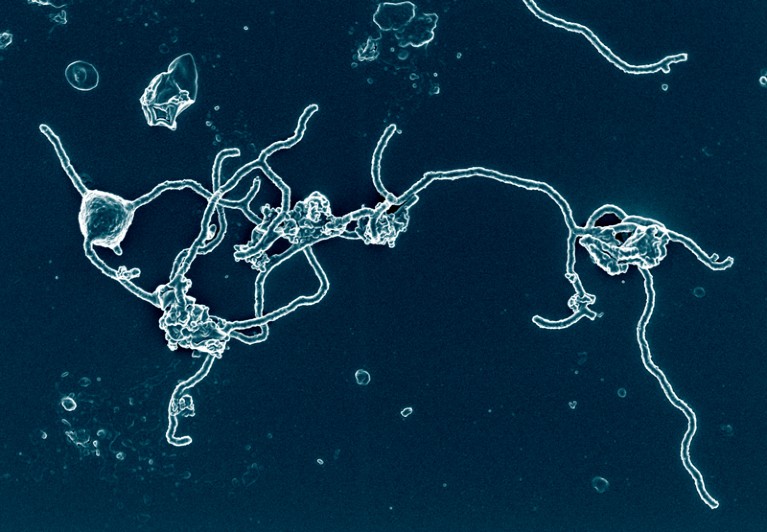
A false-coloured electron-microscopy image of an archaeon cultured in the lab.Credit: Hiroyuki Imachi, Masaru K. Nobu and JAMSTEC
Hilaire Belloc’s ‘The Microbe’ opens with the words:
The microbe is so very small / You cannot make him out at all.
The poem lists the wonders of microorganisms, and they continue to reveal their secrets to researchers more than a century after his book The Bad Child’s Book of Beasts (1896) excited and delighted children.
In 2015, researchers published the metagenome of a member of the Asgard group of archaea called Lokiarchaeota (A. Spang et al. Nature 521, 173–179; 2015). These are descended from an ancient lineage of archaea, simple cells lacking a nucleus and distinct from bacteria. This discovery was exciting because the genes were found to have similarities with those of eukaryotes — the group of organisms whose cells have nuclei and other structures, and which include plants, fungi, humans and other animals. That suggested a stronger connection between archaea and eukaryotes than had previously been thought.
Now, after a heroic effort that took 12 years, researchers led by Hiroyuki Imachi, a microbiologist at the Japan Agency for Marine-Earth Science and Technology, Yokosuka, have successfully grown a new Asgard lineage (H. Imachi et al. Nature https://doi.org/10.1038/s41586-019-1916-6; 2020). This achievement puts to rest concerns that the genes sequenced in 2015 were the result of contamination, or the initial sample being a mix of cells.
Imachi and his colleagues grew cells from sediment that had been collected below the sea bed. But why did the cells take so long to grow? The problem in culturing cells from sediment is that most microbes aren’t as obliging as familiar lab workhorses such as Escherichia coli. The researchers took up the challenge and with much patience, trial and error, they found that the cells grew best on a diet of peptides, amino acids and even baby-milk powder.
The resulting cells are tiny spheres 300–750 nanometres in diameter, but they often extrude longer, branched filaments that reach out to meet neighbouring bacteria. The researchers think that such a partnership, both biochemical and physical, could tell us more about the processes that led to the eukaryote cell being formed — a question more researchers must surely try to tackle.
Despite the promise of what is to come, a degree of caution is needed. Eukaryotes evolved more than two billion years ago, possibly coincident with an episode of global climatic change called the Great Oxidation Event. Nonetheless, the achievement brings us closer to meeting living relatives of our ancestors. We await the next chapter with anticipation.

 Read the paper: Isolation of an archaeon at the prokaryote–eukaryote interface
Read the paper: Isolation of an archaeon at the prokaryote–eukaryote interface
 Meet the relatives of our cellular ancestor
Meet the relatives of our cellular ancestor
 Complex archaea that bridge the gap between prokaryotes and eukaryotes
Complex archaea that bridge the gap between prokaryotes and eukaryotes
 Scientists glimpse oddball microbe that could help explain rise of complex life
Scientists glimpse oddball microbe that could help explain rise of complex life








